Inverse Source Identification by the Modified Regularization Method on Poisson Equation
Abstract
This paper deals with an inverse problem for identifying an unknown source which depends only on one variable in two-dimensional Poisson equation, with the aid of an extra measurement at an internal point. Since this problem is illposed, we obtain the regularization solution by the modified regularization method. Furthermore, we obtain the Hölder-type error estimate between the regularization solution and the exact solution. The numerical results show that the proposed method is stable and the unknown source is recovered very well.
1. Introduction
Inverse source problem is an ill posed problem that has received considerable attention from many researches in a variety of fields, such as heat conduction, crack identification, electromagnetic theory, geophysical prospecting, and pollutant detection. For the heat source identification, there have been a large number of research results for different forms of heat source [1–8]. To the authors’ knowledge, there were also a lot of researches on identification of the unknown source in the Poisson equation adopted numerical algorithms, such as the logarithmic potential method [9], the projective method [10], the Green’s function method [11], the dual reciprocity boundary element method [12], the dual reciprocity method [13, 14], and the method of fundamental solution (MFS) [15]. But, by the regularization method, there are a few papers with strict theoretical analysis on identifying the unknown source.
The problem (1.1) is mildly ill posed, and the degree of the ill posedness is equivalent to the second-order numerical differentiation. It is impossible to solve the problem (1.1) using classical methods. The major object of this paper is to use the modified regularization method to obtain the regularization solution. Meanwhile, the Hölder-type stability estimate between the regularization solution and the exact solution is obtained. In [16], the authors ever identified the unknown source on the Poisson equation on half band domain using separation of variables. But in this paper, we identified the unknown source on the Poisson equation on half unbounded domain using the Fourier Transform.
This paper is organized as follows. Section 2 analyzes the ill posedness of the identification of the unknown source and gives some auxiliary results. Section 3 gives a regularization solution and error estimate. Section 4 gives several numerical examples including both nonsmooth and discontinuous cases for the problem (1.1). Section 5 ends this paper with a brief conclusion.
2. Some Auxiliary Results
Now we give some important lemmas as follows.
Lemma 2.1. If x > 1, the following inequality:
Lemma 2.2. As 0 < μ < 1, one obtains the following inequalities:
Proof. Let
Case 1 (|ξ| ≥ ξ0 : = 1/μ). We obtain
Case 2 (1 < |ξ| < ξ0). We get
Case 3 (|ξ| ≤ 1). We obtain
Let
Case 1 (|ξ| ≤ ξ0 : = 1/μ). We obtain
3. A Modified Regularization Method and Error Estimate
Note that, for small μ, ξ2/(1 + ξ2μ2) is close to ξ2. On the contrary, if |ξ| becomes large, |ξ2/(1 + ξ2μ2) | is bounded. So, fδ,μ(x) is considered as an approximation of f(x).
Now we will give an error estimate between the regularization solution and the exact solution by the following theorem.
Theorem 3.1. Suppose f(x) is an exact solution of (1.1) given by (2.4) and fδ,μ(x) is the regularized approximation to f(x) given by (3.5). Let gδ(x) be the measured data at y = 1 satisfying (1.2). Moreover, one assumes the a priori bound (2.5) holds. If one selects
Proof. From the Parseval formula and (2.3), (3.4), (2.6), (2.7), (2.8), (1.2), (2.5), and (3.6), we obtain
Remark 3.2. If 0 < p ≤ 2,
Remark 3.3. In general, the a priori bound E in (2.5) is unknown exactly in practice. But, if we choose μ = δ1/(p+2), we can also obtain
4. Several Numerical Examples
In this section, we present three numerical examples intended to illustrate the usefulness of the proposed method. The numerical results are presented, which verify the validity of the theoretical results of this method.
The numerical examples were constructed in the following way. First we selected the exact solution f(x) of problem (1.1) and obtained the exact data function g(x) using (2.3) or (2.4). Then, we added a normally distributed perturbation to each data function giving vectors gδ. Finally, we obtained the regularization solutions using (3.4) or (3.5).
In the following, we first give an example which has the exact expression of the solutions (u(x, y), f(x)).
Example 4.1. It is easy to see that the function
Example 4.2. Consider a piecewise smooth source:
Example 4.3. Consider the following discontinuous case:
From Figures 1–3, we can see that the smaller the ε, the better the computed approximation fδ,μ(x).
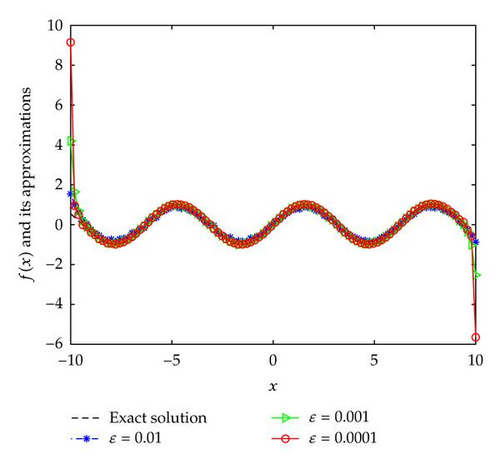
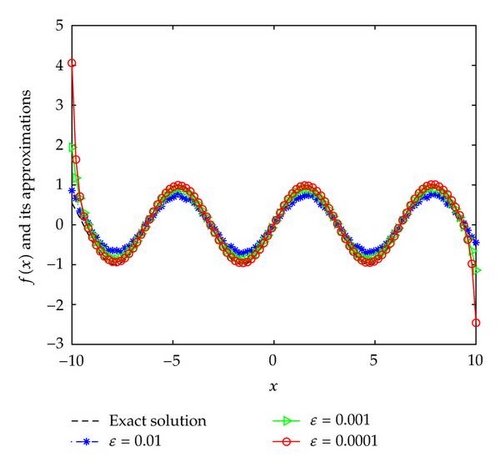
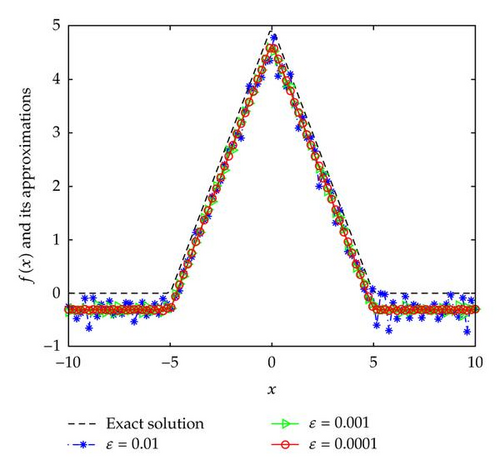
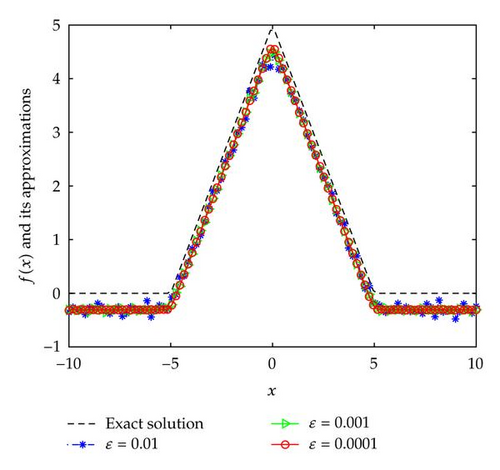
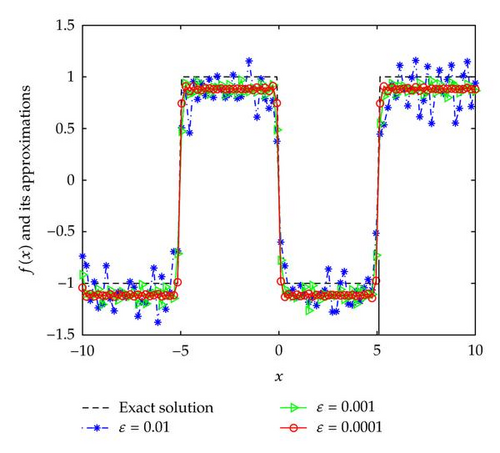
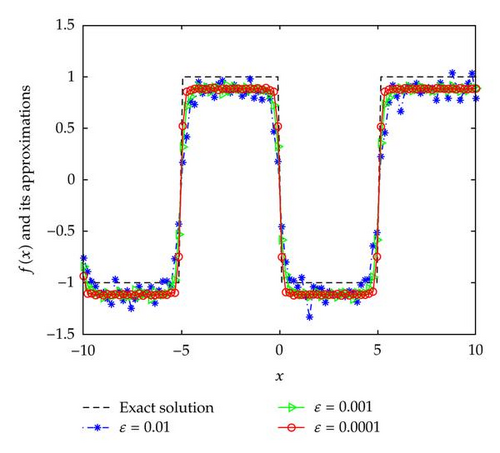
In Examples 4.2 and 4.3, since the direct problem with the source f(x) does not have an analytical solution, the data g(x) is obtained by solving the direct problem. From Figures 2 and 3, we can see that the numerical solutions are less ideal than that of Example 4.1. It is not difficult to see that the well-known Gibbs phenomenon and the recovered data near the nonsmooth and discontinuities points are not accurate. Taking into consideration the ill posedness of the problem, the results presented in Figures 2 and 3 are reasonable.
5. Conclusions
In this paper, we consider the identification of an unknown source term depending only on one variable in two-dimensional Poisson equation. This problem is ill posed, that is, the solution (if it exists) does not depend on the input data. We obtain the regularization solution and a Hölder-type error estimate. Through the comparison between [16] and this paper, as the degree inverse problem of the ill posedness of identifying the unknown source dependent only on one variable in two-dimensional Poisson equation is equivalent to the second-order numerical differentiation, we obtain the same error estimate 2δp/(p+2)E2/(p+2)(1 + 1/2max {1, (δ/E)(2−p)/(p+2)}). According to [26], this Hölder-type error estimate is order optimal.
Acknowledgment
This research is supported by the Distinguished Young Scholars Fund of Lanzhou University of Technology (Q201015).




